Chiswick House, barely five miles as the crow flies from central London, is one of the capital’s hidden gems. Georgiana, Duchess of Devonshire called it ‘my earthly paradise’ .
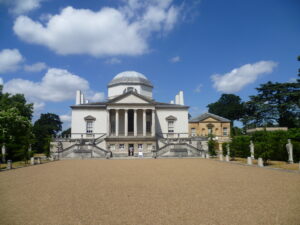
Chiswick House
Chiswick House was built in the 1720s as a summer villa, and it is unusual in that it was actually designed by its owner, the 3rd Earl of Burlington, who was passionately interested in Palladian architecture. It was simply not done at the time for an aristocrat to be a professional architect, capable of designing his own house – though he did employ a mason-contractor, too. But the Earl took his interest in architecture seriously. When he was in Rome, he acquired a copy of Andreas Palladio’s I quattro libri dell’architettura and made architectural notes in the blank pages. He also bought a number of drawings by Palladio himself which had once belonged to the 17th century architect, Inigo Jones.
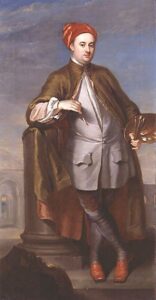
Richard Boyle, 3rd Earl of Burlington by Jonathan Richardson, 1718, Courtesy of the National Portrait Gallery
In 1714, the nineteen-year-old earl visited Italy for the first time on the Grand Tour. He returned with eight hundred and seventy-eight trunks full of paintings by the Old Masters, porphyry urns, statues etc., as well as a number of important treatises and drawings by Palladio himself.
He also returned with William Kent – see below.
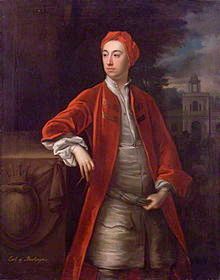
William Kent (1686-1714) by Bartholomew Dandridge, 1736. Courtesy of the National Portrait Gallery.
William Kent looks like a more flamboyant version of the Earl. The floppy red turban was obviously de rigeur in Italian artistic circles.
Born in humble circumstances in Bridlington, Yorkshire, Kent’s spelling and grammar left a lot to be desired. His first job was as a sign and coach painter where his talent was recognized and money was found to send him to study art in Rome which is where he met the Earl of Burlington. Kent hoped to become an artist but, eventually, he had to recognize that, although he was perfectly competent, he was just not good enough to be a top artist. However, he proved to be an exceptional architect and, like the Earl of Burlington, he was also inspired by Palladio.
Surprisingly, the two men hit if off: the Earl was chilly, reserved and aristocratic. Kent was easy-going, boozy, and warm-hearted. He behaved toward the Earl with a sort of happy familiarity which the Earl seems to have enjoyed. Kent inspired affection in almost everyone who met him – which included most of the cultured aristocracy of the day. He might look scruffy, talk with a Yorkshire accent, and he was obviously ‘not a gentleman’ but that didn’t matter. He didn’t stand on ceremony and he was willing to turn his hand to anything, for example Prince Frederick’s royal barge – see below.
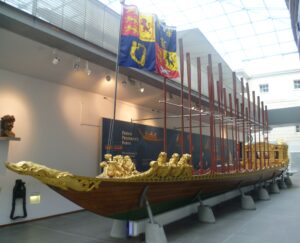
Prince Frederick’s Royal Barge designed by William Kent
However, back to the story.
Burlington brought Kent back to England where he became a life-long friend, acting as architectural tutor and adviser on the building of Chiswick House, the designing of the rooms, and helping his patron set out the gardens. When he died in 1748, he was buried in the Burlington family vault – as if he were one of the family.
Chiswick House is curious in that it’s more of a summer house-cum-picture gallery than a house to be lived in; there were no kitchen facilities or bedrooms, for example. (For that, they used the old Jacobean house next door.) It was intended as a select venue for parties and picnics, and to house the Earl’s library and pictures. So let’s start indoors. The rooms are actually quite small, compared with other homes belonging to the aristocracy

The Gallery
What is interesting about this room is that, although it is called ‘The Gallery’ there are no pictures hanging in it – there simply isn’t room. Instead, the gallery – really three rooms connected by small arches – is full of architectural features: doors with pediments, an elaborate chimneypiece, diamond-patterned coffering, picked out in gold, in the two apses and so on. You can just see the top half of one of the huge porphyry urns brought back from Italy by Kent.
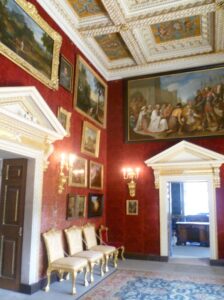
The Red Velvet Room
The Red Velvet Room is on the first floor and specifically designed to show off the paintings Lord Burlington had brought back from Italy. The ceiling panels, painted by Kent, depict an Allegory of the Arts. There are various masonic symbols in the Architecture panel – Kent and Burlington were almost certainly freemasons – and red was the colour of the Royal Arch masonic lodge; the room was a suitable size for masonic meetings. It was also an ante room to the Earl’s study – you can see his desk through the open door.
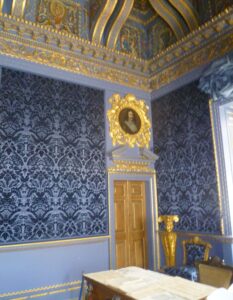
The Blue Velvet Room
The guide book called the Blue Velvet Room, ‘A sumptuous little room; the most richly decorated in the house’ and you can see that this is true. When I first visited Chiswick House, back in 2007, the velvet-flocked wallpaper had faded to a dusty bluish-grey and was threadbare in places. Since then, English Heritage have done a lot of work on the house and the Blue Velvet Room wallpaper and the curtains have been recreated to show what they looked like originally – and, standing inside it is like being inside an expensively-lined jewel casket. The Earl liked to spread out items from his Palladio collection on the desk to show visitors.
Turning to the gardens: when I visited Chiswick House in 2007, the gardens were full of mud, trenches and bulldozers – the Italian garden was about to be restored to its original state. And the pictures below show what the gardens originally looked like.
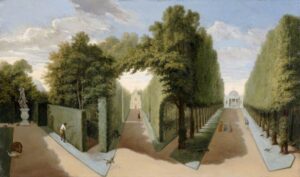
The Patte d’oie (goose foot) showing three radiating paths, as we can see above, was a popular feature in the late 17th– early 18th centuries. The Earl decided that each of the three paths in his patte d’oie would end in an ornamental building of some sort.

Unfortunately, this painting isn’t as clear as I’d like. It shows two two ladies and a gentleman crossing a bridge over a water feature whilst a gardener, in blue at the front, is crouching down with his shears doing something. The second lady has turned back and is, perhaps, asking him about his job – which would be a very reasonable question – what is he doing?
Other Rysbrach paintings in the house, also dating from the late 1720s, show beautifully-dressed ladies and gentlemen strolling around the grounds admiring the ornamental lake, the exotic birds and the Ionian temple, whilst busy gardeners go about their work to keep the place immaculate.
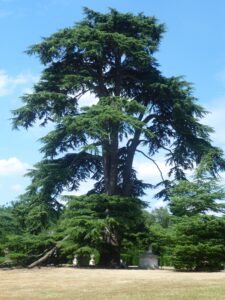
The Cedar of Lebanon
A lot of restoration work has now been done to reveal the original vistas and the numerous garden ornaments and buildings have been repaired – more on this in a moment. The cedar of Lebanon looks magnificent.
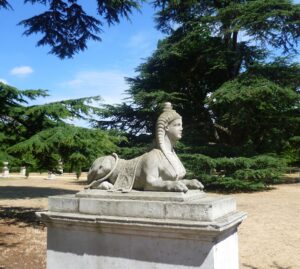
One of the sphinxes
It’s a delightful place to wander round in – I’ve always loved sphinxes, and there are three in the gardens to admire like the one above with the cedar of Lebanon – or at least the lower branches – in the background.
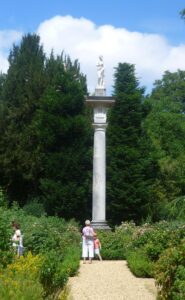
Doric column with Venus
There are a number of straight paths with high clipped hedges on each side, and a ‘feature’ at the end. The photo above shows a tall Doric column with a copy of the statue of Venus de Medici on top at the end of one of the paths. William Kent did a small sketch of it and put a peacock strutting about on the gravel in front to add to the classical atmosphere.

The Ionic Temple with obelisk in what was once the Orange Tree Garden
According to a sketch by Ruysbrack, the Orange Tree Garden originally had three grass terraces going down to a circular pond, surrounded by a triple circle of neatly pruned orange trees in large tubs. The temple looks a bit neglected nowadays but restoring gardens is expensive and doubtless the money didn’t run to terraces or orange trees.

The Temple from the other side showing part of the lake
Behind the temple is a long lake which stretches down the entire length of the gardens. Here the countryside is allowed in.
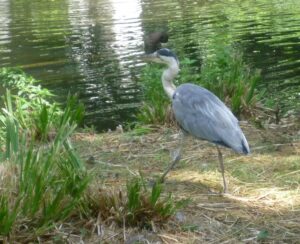
A heron
A heron stalks majestically towards the lake.
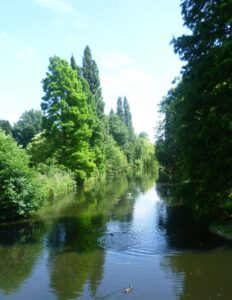
Swans and ducks on the lake – almost invisible but I assure you that they are there
It’s a very different atmosphere from the formality of the Italian garden on the other side of the house. My photographs were taken a few years after my first visit when the bulldozers were preparing to restore the gardens. Sadly, the formal Italian gardens I’d been looking forward to seeing were a disappointment.
It’s all very well to restore gardens to their former glory but one dry summer and too few gardeners to prune and water can very quickly turn a garden into a forest of dried-out sticks. I did take some photos but deleted them – they just looked too depressing. If you look at the grassy areas in the photos you can see how yellow and dry it looks.
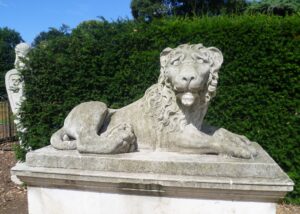
Stone lion
Fortunately, there is still a stone lion to enjoy. And when you feel like a rest, there’s a very nice café where you can sit outside under a table with a parasol and admire the view.
The house itself is managed by English Heritage and there is a charge for entry, but the gardens, which are owned and managed by the London Borough of Hounslow, are free for everybody to enjoy. And all this not much more than half an hour from central London.
Photos by Elizabeth Hawksley unless otherwise stated.
Elizabeth Hawksley
Please share this page...
Lovely! I haven’t visited Chiswick house for many years. It looks as though it will be quite different now!
I do love the expression on that lion.
Thank you for your comment, Jan – it made me smile. I agree – the lion does not look very bright. He reminds me a bit of Pooh bear – ‘I am a bear/lion of very little brain.’
What an enchanting building, and the gardens are fabulous. Or will be when completed, if they match the original paintings. It just gives you an idea of the fabulous wealth of these aristocrats when you talk about all those trunks full of art and artefacts from Italy. Never visited this place, but I can see it’s certainly worth going.
Thank you for your comment, Elizabeth. You are certainly right about the fabulous wealth needed to buy all those antiques and paintings. And the Earl was only 19 when he first went to Rome! He could so easily have turned into one of those debt-ridden aristocrats who owed thousands of pounds to various wretched dealers, as so many aristocrats did without a qualm.
We went early in the spring one year when the camellias were in bloom both outside and in urns in the glassed in galleries. There is a spectacular collection.
How wonderful, Pauline! I’d love to see that! Fingers crossed for next spring.
I remember reading about Chiswick house from my Architectural history text book. I am very happy to have learned a little more of its history.
The next time that I am in London, I shall have to make the trip out there; I had no idea it was so accessible.
Thank you for your comment, Huon. I think you’d enjoy wandering around the gardens. It’s much larger than I made it sound. If I were to go again, I’d take the Guide book with me, with the page containing the map of the grounds open, and try and track down some of the old features, such as Napoleon’s Walk and Rustic Home – not that Napoleon himself ever went there, but I’d like to see what’s left of it.